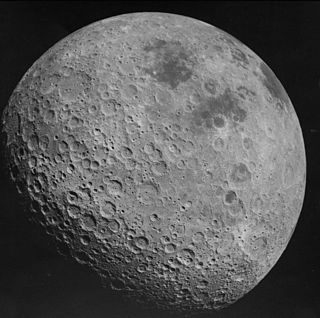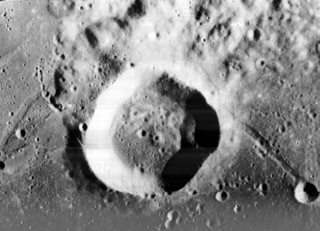Swift as a crater may refer to:
| This article includes a list of related items that share the same name (or similar names). If an internal link incorrectly led you here, you may wish to change the link to point directly to the intended article. |
Swift as a crater may refer to:
| This article includes a list of related items that share the same name (or similar names). If an internal link incorrectly led you here, you may wish to change the link to point directly to the intended article. |

An impact crater is an approximately circular depression in the surface of a planet, moon, or other solid body in the Solar System or elsewhere, formed by the hypervelocity impact of a smaller body. In contrast to volcanic craters, which result from explosion or internal collapse, impact craters typically have raised rims and floors that are lower in elevation than the surrounding terrain. Impact craters range from small, simple, bowl-shaped depressions to large, complex, multi-ringed impact basins. Meteor Crater is a well-known example of a small impact crater on Earth.

Jonathan Swift was an Anglo-Irish satirist, essayist, political pamphleteer, poet and cleric who became Dean of St Patrick's Cathedral, Dublin.

Planetary nomenclature, like terrestrial nomenclature, is a system of uniquely identifying features on the surface of a planet or natural satellite so that the features can be easily located, described, and discussed. Since the invention of the telescope, astronomers have given names to the surface features they have discerned, especially on the Moon and Mars. To standardize planetary nomenclature, the International Astronomical Union (IAU) was assigned in 1919 the task of selecting official names for features on solar system bodies.

Mount St. Helens is an active stratovolcano located in Skamania County, Washington, in the Pacific Northwest region of the United States. It is 50 miles (80 km) northeast of Portland, Oregon and 96 miles (154 km) south of Seattle, Washington. Mount St. Helens takes its English name from the British diplomat Lord St Helens, a friend of explorer George Vancouver who made a survey of the area in the late 18th century. The volcano is located in the Cascade Range and is part of the Cascade Volcanic Arc, a segment of the Pacific Ring of Fire that includes over 160 active volcanoes. This volcano is well known for its ash explosions and pyroclastic flows.

Gulliver's Travels, or Travels into Several Remote Nations of the World. In Four Parts. By Lemuel Gulliver, First a Surgeon, and then a Captain of Several Ships, is a prose satire by Irish writer and clergyman Jonathan Swift, that is both a satire on human nature and the "travellers' tales" literary subgenre. It is Swift's best known full-length work, and a classic of English literature. He himself claimed that he wrote Gulliver's Travels "to vex the world rather than divert it".

Mare Crisium is a lunar mare located in the Moon's Crisium basin, just northeast of Mare Tranquillitatis. The basin is of the Pre-Imbrian period, 4.55 to 3.85 billion years ago.

Lemuel Gulliver is the fictional protagonist and narrator of Gulliver's Travels, a novel written by Jonathan Swift, first published in 1726.

Lewis A. Swift was an American astronomer who discovered 13 comets and 1,248 previously uncatalogued nebulae. Only William Herschel discovered more nebulae visually.

The far side of the Moon is the hemisphere of the Moon that always faces away from Earth. The far side's terrain is rugged with a multitude of impact craters and relatively few flat lunar maria. It has one of the largest craters in the Solar System, the South Pole–Aitken basin. Both sides of the Moon experience two weeks of sunlight followed by two weeks of night; the far side is sometimes called the "dark side of the Moon", meaning unseen rather than lacking light.
Chapman may refer to:
Swifts are birds in the order Apodiformes.

Swift is a small lunar impact crater that is located in the northwestern part of the Mare Crisium, in the northeast part of the Moon's near side. Within two crater diameters to the south is the larger crater Peirce. It was named after American astronomer Lewis A. Swift. Swift was previously designated Peirce B.

Lunar craters are impact craters on Earth's Moon. The Moon's surface has many craters, almost all of which were formed by impacts.

The two moons of Mars are Phobos and Deimos. Both were discovered by Asaph Hall in August 1877 and are named after the Greek mythological twin characters Phobos (panic/fear) and Deimos (terror/dread) who accompanied their father Ares into battle. Ares, god of war, was known to the Romans as Mars.
Taytay may refer to:

Taylor Alison Swift is an American singer-songwriter. As one of the world's leading contemporary recording artists, she is known for narrative songs about her personal life, which has received widespread media coverage.
Mars has two moons, Phobos and Deimos. Due to their small size, both moons were discovered only in 1877, by astronomer Asaph Hall. Nevertheless, they frequently feature in works of science fiction.

Swift crater is a crater on Mars's moon Deimos. It is about 3 km (1.9 mi) in diameter. Swift crater is named after Jonathan Swift, whose 1726 book Gulliver's Travels predicted the existence of two moons of Mars. Swift crater is one of two named features on Deimos, the other being Voltaire crater. On 10 July 2006, Mars Global Surveyor took an image of Deimos from 22,985 km (14,282 mi) away showing Swift crater.

Voltaire is an impact crater on Mars's moon Deimos and is approximately 3 km (1.9 mi) across. Voltaire crater is named after François-Marie Arouet, a French Enlightenment writer who was better known by the pen name Voltaire, who in his 1752 short story "Micromégas" predicted that Mars had two moons. Voltaire crater is one of two named features on Deimos, the other being Swift crater. On 10 July 2006, Mars Global Surveyor took an image of Deimos from 22,985 km (14,282 mi) away showing Voltaire crater and Swift crater.

Fogo Natural Park, on the island of Fogo, is one of ten "natural parks" in the country of Cape Verde. The protected area is 84.69 km2 (32.70 sq mi), which is 17.8% of the total area of the island. 50% of the park lies within the municipality Santa Catarina do Fogo, 28% in municipality of Mosteiros and 22% in São Filipe. The natural park is situated in the interior of the island, and covers the volcano Pico do Fogo, its crater and crater rim (Bordeira) and the forest of Monte Velha. The volcano is active; the most recent eruption was in 2014-15.